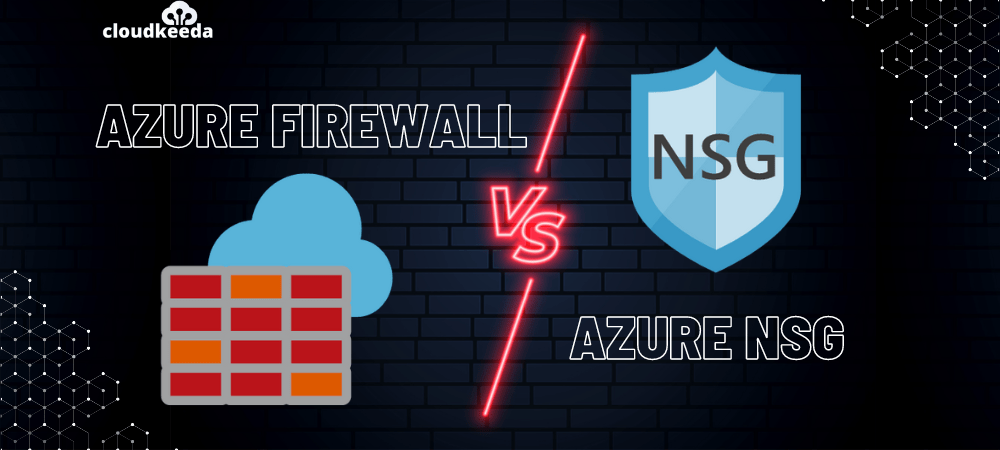When using a cloud service, one of the most important security measures is to monitor and manage incoming and outgoing traffic.
Resources may include virtual machines running SQL Server, other web applications, or domain services. There are two types of security services offered by Microsoft Azure for controlling how traffic enters and exits resources. Known as Azure Firewall and Network Security Groups (NSGs), these services protect your network.
This article will examine how the two differ and how they can be combined to secure traffic to Azure resources.
The topics covered in this blog are:
- What is Azure Firewall?
- How Does Azure Firewall Work?
- Azure Firewall Features
- What is Azure NSG?
- How Does Azure NSG Work?
- Azure NSG Features
- Azure Firewall vs NSG
- Azure Fireaall vs NSG: Features Comparison
- Conclusion
- FAQs
What is Azure Firewall?
Azure Firewall secures network traffic with its contents using network security services. In a nutshell, it detects the workloads in the VNet and protects the resources from malicious traffic. The Azure Firewall is a Windows-based network security service that operates at OSI layers 4 and 7. In order to apply the Azure Firewall, we just need to set up the rules such as Network rules, Nat rules, and Application rules.

How Does Azure Firewall Work?
Microsoft Azure Firewall provides various features that can be used to control the network traffic that flows in and out. The Azure Firewall provides high availability without requiring the use of a load balancer. By enabling Azure Firewall’s Availability Zones feature, you can ensure 99.9% availability by using availability zones.
In addition, Azure Firewall offers unlimited scalability at no extra cost. If you specify the service’s FQDN, you can restrict outbound traffic access. You can create Azure Firewall rules that filter incoming traffic based on source IPs, destination IPs, ports, and protocol types. You can assign either an Allow or Deny status to these rules. By enabling the threat intelligence feature, you will receive alerts when specific malicious IP addresses are being sent or received.

Azure Firewall Features
- The Azure Firewall service provides robust protection and is fully managed.
- There are tons of features in this software that ensure your resources are protected to their maximum capacity.
- In addition to L3 traffic, L4 traffic, and L7 application traffic can be analyzed and filtered.
- Firewall support for application FQDN tags is provided by Azure Firewall.
- With it, you can mask the destination and source network addresses
- Using threat intelligence as a filter, it provides filtering options.
Also check: Our blog post on Azure Certification Path
What is Azure NSG?
Network Security Groups (NSGs) provide network security for the exchange of traffic within and between Azure VNets. The service is OSI layer 3 & 4 network security-oriented. An Azure NSG comprises a number of security rules that can be enabled or disabled by the user. A five-tuple hash is used to evaluate these rules. An IP address, a port number, a destination IP address, a port number, and the protocol type are included in this 5-tuple hash. It is possible to associate Network Security Groups with a VNet or VM network interface.

How Does Azure NSG Work?
In order to protect virtual networks, Microsoft offers a Network Security Group (NSG). Different types of network traffic flows can be organized, filtered, directed, and limited with this application. Each Azure Network Security Group can be configured according to different inbound and outbound rules to permit or deny a particular type of traffic.
Each NSG can accommodate an Azure virtual network requiring access to your resources. Before making use of Networks Security Groups, you must create them. When you create an NSG, you have the option of configuring its individual rules. Using rules, one can determine whether network traffic that flows in or out is safe to allow or not.

Azure NSG Features
- Azure Network security is used to filter traffic at the network layer.
- Network Security comfortably organize, filter, direct and limit various network traffic flows.
- It allows setting different inbound and outbound rules to allow or deny a specific type of traffic to configure Azure Network Security Group.
- For using, Azure Network Security Groups, you need to create it and configure individual rules.
Check Out: Top 30 ADF interview questions
Azure Firewall vs NSG
Azure Firewall is a robust and fully managed firewall service. | Azure NSG is a basic firewall. |
Azure Firewall come with dozen of features to ensure maximum protection of your azure resources. | Azure NSG is used to filter traffic at the network layer. |
Azure Firewall can analyze and filter L3, L4 traffic, and L7 application traffic. | This feature is not available in Azure Network Security Groups. |
Microsoft Azure Firewall supports application FQDN tags. | Azure Network Securty Groups doesn’t supports application FQDN tags. |
Azure Firewall lets you mask the source and destination network addresses | Azure Network Securty Groups doesn’t supports this feature. |
Azure Firewall offers a threat intelligence-based filtering option. | This feature is not available in Azure NSG. |
Azure Fireaall vs NSG: Features Comparison
Let’s now compare Azure Firewall and Azure NSG based on their features.
Service Tags
A service tag acts as a label that identifies a range of IP addresses for certain services such as Data Lake, Container Registry, Azure Key Vault, etc. In both Azure Firewall and NSG, service tags are fully supported, but users can’t customize them since Microsoft manages them.
FQDN Tags
FQDN tags are the only ones supported by Azure Firewall. In this case, they refer to a collection of fully qualified domain names of Microsoft services such as Windows Update and Azure Backup. This information is also maintained by Microsoft, and cannot be customized.
SNAT
SNAT stands for Source Network Address Translation. This is only supported by the Azure Firewall. You can use this feature to mask the IP address of Azure resources that are sending out traffic via the Firewall by configuring it with a public IP address.
DNAT
DNAT stands for Destination Address Translation. Azure Firewall uses this feature to translate incoming traffic to the firewall’s public IP address to the private IP addresses of a VNet.
Conclusion
The battle between Azure Firewall and NSG continues to escalate. These two services are Microsoft’s primary security offerings. Everyone is unique in the ways that it offers network security. An Azure Firewall is an intelligent solution that filters network traffic. In contrast, Azure Network Security Group provides security to both inbound and outbound network traffic based on basic rules. As a whole, Azure Firewall is a complete package and has a slight advantage over Azure Security Groups.
FAQs
Q1. What is the difference between Azure Firewall and Azure NSGs?
Azure Firewall and Azure NSGs differ in their scope and functionality. Azure Firewall operates at the network level, providing advanced security features like application-level filtering, while NSGs operate at the subnet or network interface level, controlling traffic based on port, protocol, and IP address.
Q2. When should I use Azure Firewall instead of Azure NSGs?
Azure Firewall is suitable when you require application-level filtering, centralized management, and advanced security features. Azure NSGs are ideal for basic network-level filtering and traffic control within subnets or network interfaces.
Q3. Can I use Azure Firewall and Azure NSGs together?
Yes, Azure Firewall and Azure NSGs can be used together in a security architecture. Azure Firewall can provide centralized security for inbound and outbound traffic, while NSGs can be applied at the subnet or network interface level to provide additional network-level controls.
Q4. Which one provides more granular control over network traffic, Azure Firewall or Azure NSGs?
Azure Firewall offers more granular control over network traffic as it operates at the application level, allowing you to filter traffic based on specific applications, URLs, or FQDNs. Azure NSGs, on the other hand, provide more basic port, protocol, and IP-based filtering.
Q5. Are Azure Firewall and Azure NSGs mutually exclusive, or can they complement each other in a security architecture?
Azure Firewall and Azure NSGs can complement each other in a security architecture. Azure Firewall provides advanced application-level filtering and centralized management, while Azure NSGs offer network-level filtering within subnets or network interfaces. Combining both allows for a layered security approach, addressing different aspects of network traffic control and protection.
Related/References
- TOP 60+ Azure Interview Questions and Answers
- What is Microsoft Cloud Background Check?
- Top 10 Microsoft Azure Security Best Practices
- Top 11 Reasons to Get a Microsoft Azure Certification
- Azure Durable Functions: Benefits, Types, and Patterns
- What is Microsoft Azure Recovery Services Vault?
- What is Azure Firewall? – MS Doc
- Azure Network security groups – MS Doc

